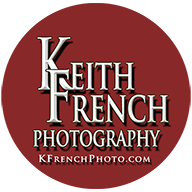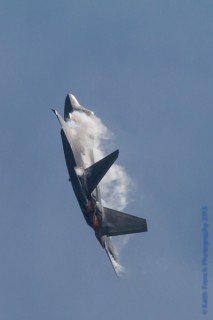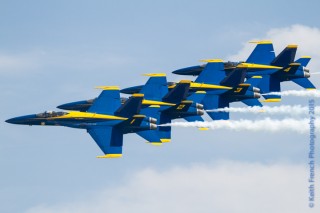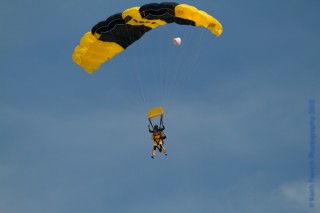Photographing Airshows
The arrival of summer brings the airshow circuit back to life in the Upper Midwest. For many the sights and sounds of high performance jets and vintage war bird aircraft is enough to bring chills up and down their back. For others like me the chills are only half the thrill, nailing a few sharp close ups of these aircraft in flight is the payout of excitement. I like to walk the static line too, the parked air aircraft on display, and try to set up a few "artsy" shots. These tend to be a little tough only because there are usually spectators in the way to crowd the shot, or the aircraft are cordoned off keeping the crowds back 10-15 feet. For that purpose I usually pull out a short telephoto lens and shoot parts or sections of the airframe looking for angles or patterns with a blend of color or contrast or a combination of them all. Many airshow photographers bring some very wide angle lenses with them, and while there is often an opportunity to use one if you can ever get on board or in the cockpit of one of these beauties, most of the time your desired subject fills only 40% of the frame and a lot of unwanted back ground and foreground makes its way into the frame as well. If static displays are why you are attending, get there early. If the gates open at 8 AM be there for that, and make a bee-line for the tarmac staging the static display. You'll want to work that line fast because people will fill in fast. There is also the chance that the owners of the display aircraft will not have their craft in display shape, so getting there too early you may catch them cleaning it, or setting up information tables. Many of these aircraft arrive late on Friday afternoon, or early evening. After a long day of routing around weather, and making fuel stops they wait until the morning of the airshow to clean up the bird. Especially vintage war bird aircraft, many of them leave streams of oil down the sides or the underbelly of the aircraft so you catch the crew with spray cleaner and a long broom like brushes dissolving the oil. There may be a photo op there but not likely. Depending on your photography style you'll find a shot or two of every aircraft if you arrive as early as possible.
Another very good reason to get there early is to claim your viewing spot in spectators row. Most aerial performances begin at noon. So the crowds, not thinking about static displays tend to begin arriving in hordes about 11:15 looking to pick a good vantage point to view from. Once again arriving as the gates open, with your nylon folding chair and cooler, you can walk right up to the fence marking the viewing area and set up to claim your piece of terra firma for the show. The two reasons for getting right along the fence is minimizing the chance that some 6 foot 7 guy gets in front of you blocking your view of the low altitude portion of the aerial ballet and also many great photos ops are occurring right on the runway or taxi way that the fence is paralleling. At some airshows they also include a little pyrotechnics so having an unobstructed view is critical. [ Image 3 L-29 Smoke] Another obstacle for intrusion to look for is the large poll mounted speakers. For the uninformed spectator these are great, running commentary during a performance explaining what the pilot just did or will do next as well as what the laws of physics are doing to the pilots body while performing is useful information to some. But for a photographer the information is less useful when compared to how many shots these speaker stands ruin. It's not always possible to avoid them but by setting up far left or far right at least they are only off to one side and not both sides as if you set up somewhere in the middle. So here is a few words about what to bring for creature comforts. The chair is critical because you will have a lot of sitting time especially if you arrive right at gates open. A cooler as mentioned but either keep it small because you are caring everything plus your camera gear bag, or go big and get a cooler on wheels, or in a wagon to store and tow everything. Airshows are at airports most of the time and there is always a long walk regardless of where you are. Why a cooler at all? Well $10 hamburgers and $6 beverages are good reasons. By 10 am the air will be filled with the aroma of all kinds of food favorites, far too many to describe. Many ethnicities are covered as well as ice specialties and desserts. Those awesome smells will be tugging at you all day and if you're not careful you'll unload $50 before you even feel like you ate something. So pack a cooler with lots of good rehydrating liquids and your favorite foods and snacks. Make sure you especially remember to pack some SPF 30 sunscreen as well because there is no shade. Of course make sure you check the air show's web site. Usually listed under the FAQs. I know for sure Rockford, IL's Airfest does not allow any outside food or beverages. They actually set up an inspection table for entrants and have you open your camera bag and back packs. They do let you go back to your car and reenter but it's a long walk and photographically there is away something performing during the time one normally eats. Every show is different so thoroughly read the FAQ section.
Since I'm on the topic of saving money, if you can prepay your entry ticket online you will save a lot of money. The last airshow I went to the tickets at the gate were $10 MORE per person than on line. WOW !!! Some airshows charge by the car, some per head. Some do both. (I know, brutal right ?) So visit the web site at least a week out to see what you can learn. You may find out the layout of the show, get early bird tickets, you may also find discounted tickets for one of many reasons like veteran status, or senior discount. Maybe group rates of 6 or more, or for camera clubs. You may also like to print out the schedule so you know what's coming.
Ok let's talk about the actual shooting, what gear and exposure tips. As mentioned for shooting the static displays a short telephoto comes in handy. For me my shortest lens to bring is the 24-105mm, I have brought a fish eye and there is opportunity to use it but its few and far between so to lighten the load I leave it home. I bring my 70-200mm, and I bring a 100-400mm. My primary body for the telephotos lenses is a cropped sensor Canon 7D shooting at 8.2 frames per second I get what I need to capture a fast pass. For shooting the static displays I use a full frame camera. There are several ways of setting up the camera for the air show itself. Weather is a big part in the decision as well as sun angle. For airshows facing a more southerly direction you will be shooting strong back lit subjects, if you have a thin white cloud layer vs. blue sky, even more so. Your lens will also be part of the decision. The more magnification, ie, 400mm or 500mm the less sky and more airplane you have, so the less back light effect you'll have. At 400mm from the fence row, most low passes where next to filling the frame. Some even had treetops in them at the bottom of the frame. Shooting in one of the priority modes such as Tv or Av can compensate for the continuous light reading changes but it could over compensate. Shooting in Manual will do the same thing unless you are very fast on your setting adjustments and can compensate quickly as the subject moves from bright sky back into partial ground back ground. There is no one setting gets them all. However, after I say that I still try to keep it easy. I like shooting in Tv, Shutter Priority. I set the auto exposure compensation to +2/3 (+0.7 for you Nikon shooters) to compensate for some of the back lighting, I have the metering mode set for partial metering to ignore the outer edges of the frame, I shoot in RAW, and high speed continuous shutter. Unless the sky is very thick overcast ISO is usually very low, 100 or maybe 200. With todays more modern cameras having to run the ISO up to 400 or 500 to keep shutter speeds up around 1/1000 sec for the jets is a good idea too. With these settings, some of the aircraft will appear dark on the back of the camera, but you will have ability to bring them in nicely in Lightroom or Photoshop by simply adjusting the shadows and the highlights in opposite directions. Most true if the sky goes white in full cloud cover, even if it just thin wispy clouds. As far as stop action goes. Aircraft with propellers generally are slower and so I select a slower shutter, surprisingly 1/160 down to 1/60 of a second. [Image 5 C-1 Prop Arc] Mainly because I want some motion blur in the propeller. To me they don't look right flying with a stopped motion prop. So even a little spin on the prop arc looks better that frozen in space. For Jets, I'll adjust anywhere from 1/360 up to 1/2000. Doing that "on the fly" the aperture will auto correct and the shots come out pretty well. The old rule of thumb of a shutter speed at least 1x the focal length does work here. i.e. a 400mm Lens should stay above 1/400 sec shutter. Lucky for most shots, getting there early also allows you to capture a few practice performances so you can see what's working that day, in the current weather, and see what the sun angle is doing to help or hinder you. The last tool to discuss is the use of a circular polarizer (CP). There is a good argument not to use one for the actual airshow. Unless you have a very top of the line CP, using it will actually hurt your images because they are not as sharp as your glass. That does depend on the glass you are using, but if you have a $1200 or higher lens and
$40 filter I can assure you are not helping the quality of the image and when you zoom in on the computer after the show you will see a drop or loss in quality. Since you will most likely be zooming in a little more than your lens can give you for magnification sharpness is super critical. In fact if you normally use a UV filter take that off to. The less glass you shot through the better. Using the CP during the performance, depending on sun angle will deepen the blue sky, and lessen the effect of refractivity from the smoke trails that are usually a big part of performing aircraft. The static line shots I would recommend using the CP. Mainly because you right there next to the aircraft, they are highly reflective, and the polarizer will settle that reflection down. To see more images from air shows visit Airshows or More Airshows
Keith French is a full time Commercial Photographer in the Chicago area, specializing in Marketing and Advertising Photography such as product photography or architecture photography. His service as a US Marine Corps Aviator allowed him many years of practice photographing aircraft of many types around the world. To learn more about Keith, join one of his photography work shops or schedule some one-on-one classes, visit his website Kfrenchphoto or on Facebook at www.facebook.com/kfrenchphoto
When you subscribe to the blog, we will send you an e-mail when there are new updates on the site so you wouldn't miss them.



















Comments